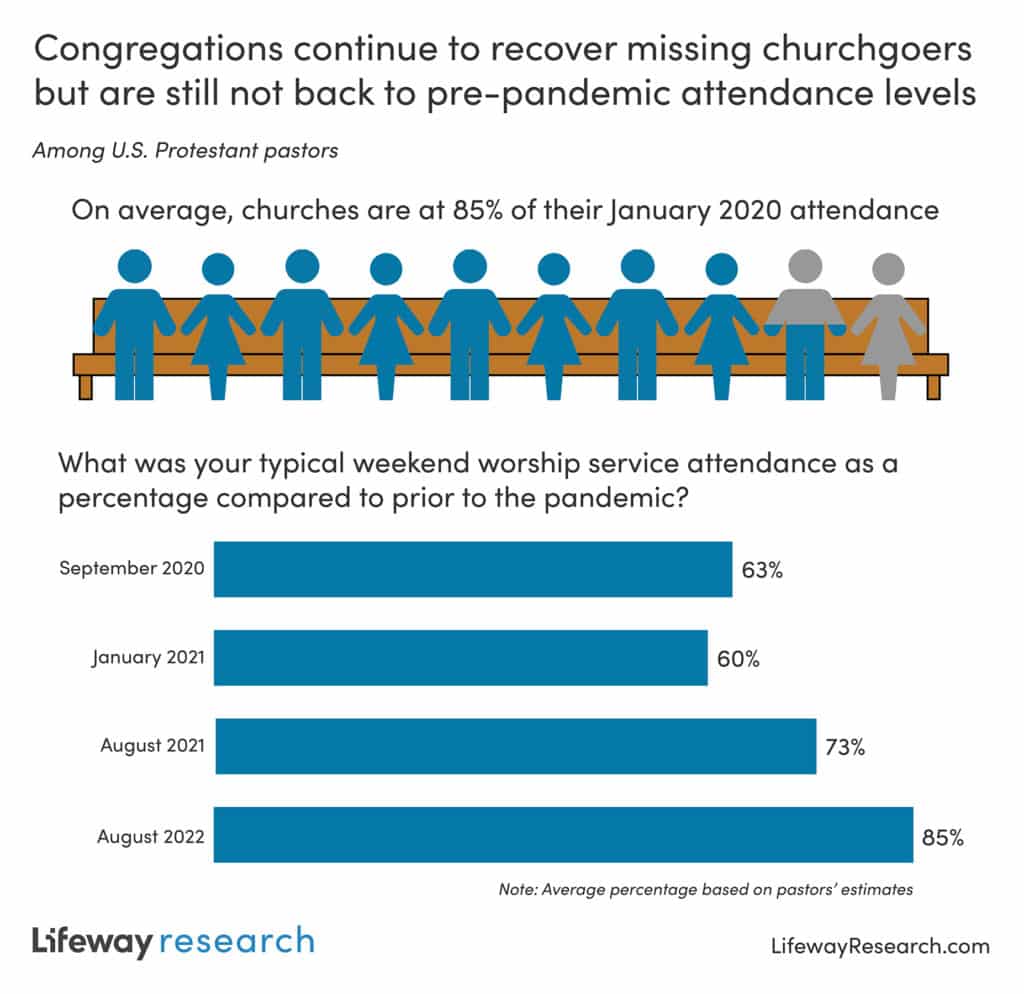NASHVILLE—Almost every church in the U.S. is holding in-person services again, but some pre-pandemic churchgoers still haven’t returned.
In August 2022, 100% of U.S. Protestant pastors (rounded to the nearest whole number) say their churches met in person, according to a Lifeway Research study. This continues the increases from the past two years of churches holding physical gatherings. In August 2021, 98% of churches gathered in person, after 75% reported the same in July 2020.
“While there are a handful of exceptions, we can definitively say that churches in the U.S. have reopened,” said Scott McConnell, executive director of Lifeway Research. “While masks began to rapidly disappear in many settings in 2022, churchgoers have not reappeared quite as fast.”
Attendance adjustment
Despite churches returning to pre-pandemic levels of holding in-person services, not all churchgoers have followed suit. On average, U.S. Protestant churches report current attendance at 85% of their typical Sunday morning crowds in January 2020, prior to the COVID-19 outbreak.
Despite falling below a full return, this marks the highest attendance levels in more than two years. In September 2020, the average church reported 63% of their pre-pandemic in-person attendance. Last August, the percentage climbed to 73%, before rising another 12 percentage points this year.
In February 2021, 91% of U.S. Protestant churchgoers told Lifeway Research that once COVID-19 was no longer an active threat, they planned to attend worship services at their church at least as much as they did prior to the pandemic.
Earlier this year, 34% of Christians said they attended a worship service four times a month or more before COVID, according to an additional Lifeway Research study. In April 2022, 26% said they currently attend that often. Slightly more than a third of Christians (36%) said they attended less than once a month before the pandemic. This year, that jumped to 43%.
“While some pre-COVID churchgoers have not returned to church at all, much of the decline in attendance is from people who are attending less often,” said McConnell.
Areas of growth
While most U.S. Protestant churches still haven’t fully recovered pre-pandemic attendance levels, more congregations than before have now reached those numbers or even grown.
In September 2020, almost twice as many congregations reported being below 50% of their January 2020 attendance as said they were at least at 90% (29% vs. 15%). Now, less than 1 in 10 congregations (8%) is still below half of their pre-COVID attendance numbers. Today, more than a third (35%) report at least 90% attendance, including almost 1 in 6 pastors (17%) who say their congregation has grown since January 2020.
Most churches continue to be in the middle range—above 50% of their pre-pandemic attendance but below 90%. A quarter of churches (26%) say their attendance is more than 50% but less than 70%, while 31% report a congregation of 70% to less than 90% what it was prior to COVID-19.
“As has been the case since COVID began, different churches are having different experiences,” said McConnell. “More than a third are at 90% or more of pre-pandemic attendance. More than a third are stuck with less than 70% of their people back on a typical Sunday. And, just under a third are in between 70% and less than 90% attending.”
Older pastors are less likely to report their church growing in attendance since the pandemic began. Around 1 in 6 pastors 65 and older (16%) say their congregations increased attendance since January 2020 compared to 25% of pastors aged 45-55 and 33% of pastors 18-44. Those in the Midwest (26%) and South (25%) are more likely to say they’ve grown compared to those in the Northeast (14%).
Evangelical pastors (29%) are almost twice as likely as mainline pastors (16%) to report pandemic attendance growth. Pentecostal (33%) and Baptist (28%) pastors are more likely to say they’ve grown since January 2020 than those at Presbyterian/Reformed (14%), Lutheran (13%), Restorationist Movement (10%) or Methodist (8%) churches. Non-denominational pastors are among the most likely to report growth (30%) but also the most likely to say their church is still less than 30% of pre-COVID attendance (14%).
Fewer churches climbing above 100
The failure of churches to recapture all their pre-COVID churchgoers means even fewer churches reach 100 in attendance on a typical weekend. Now, 2 in 3 U.S. Protestant churches (68%) have congregations of fewer than 100 people, including 31% who have fewer than 50. A quarter of churches (24%) fall into the 100-249 range, while 8% of congregations host 250 people or more each week.
Almost half of the oldest pastors are leading the smallest congregations. Pastors 65 and older (47%) are most likely to be leading churches with fewer than 50 on a typical weekend. Mainline pastors (38%) are more likely than evangelical pastors (26%) to be leading congregations of fewer than 50. Denominationally, the smallest churches are more likely to be Presbyterian/Reformed (50%) or Methodist (42%) than Pentecostal (27%) or Baptist (22%). The smallest congregations are also most likely to be in the Northeast (45%).
Still, the smallest congregations are among those most likely to have recovered to pre-COVID levels. Those who reported attendance of fewer than 50 in January 2020 (49%) are more likely to currently say they are at 90% or greater of those pre-pandemic levels than those with 50 to 99 (34%) and 100 to 249 (28%) in pre-pandemic attendance.














